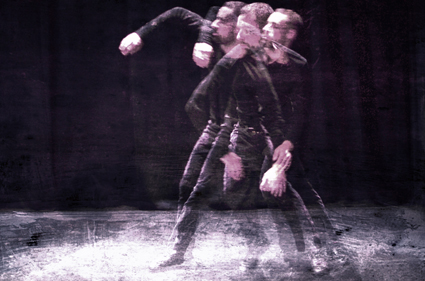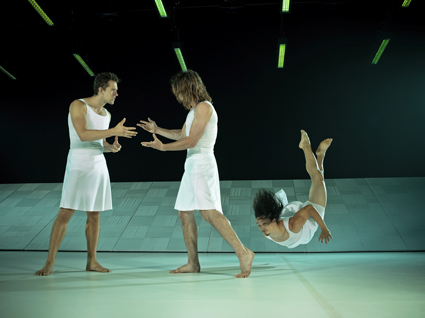the body: beginning and end
keith gallasch: matthew day, intermission; adt, be your self

Matthew Day, Intermission
image James Brown
Matthew Day, Intermission, photo James Brown
intermission
Compared with Thousands and Cannibal, the other parts of his Trilogy, Matthew Day’s Intermission unfolds as if from the dark night of a dancer’s soul, one whose body is trapped in the waves of stress from an ever mounting Sisyphean labour. If you hadn’t seen the first two works with their droll ruptures in otherwise exacting flows of magical transformations, you might well have wondered what you’d walked into.
Intermission is black—gloves, clothing, floor, enveloping curtains and mood. The sound score is an oscillating, increasingly multi-layered and intensifying hum. Day’s initial moves seem, as ever, to emerge from a tense stasis. A shoulder moves back. A heel lifts. What appears to be a kind of walking on the spot takes shape with a slight sway; but Day is actually on the move, circling in a wide arc to the curtains behind, almost merging with the blackness on our right. Turning back to us, he executes an extremely slow right leg lunge, right arm leading. He gradually extends his arms and raises his hands in an ambiguous, weighty supplication to be repeated over and over. The overarching pattern, more elaborate in detail than I have words for, moves to our left, the sound slipping away and then resurgent with attendant bright light until Day, with that abstractly imploring gesture, stops.
Intermission feels personal and purgatorial, although Day’s interests as expressed in interviews and his program notes indicate no such inclination towards self-exploration. Even so, the work is a dark pleasure, its grim beauty born of its curious suggestiveness and a relentless wave structure. When I interviewed Day for RealTime he explained, “while I was performing (Cannibal) I started to discover a wave in the vibration. It’s just a very simple thing about the weight shifting between the right and the left foot, the transference of weight across the body and across space—the eternal wave that’s present underneath that” (RT109).
Ideally, intermission needs to be seen in close proximity with Thousands and Cannibal in order to fully absorb the binding power of stillness, vibration and wave movement that make Matthew Day’s Trilogy a very strange and fascinating creation.
be your self

ADT dancers, Be Your Self
photo Chris Herzfeld
ADT dancers, Be Your Self
Garry Stewart’s Be Your Self for ADT is, for all its raw humour and reverie, an essentially dark or perhaps simply realistic account of the disconnect between ourselves and our bodies and the likely inevitably of our species simply slipping back into the great ecological soup. Physical movement in this work is initially described in a slather of neurobiological terminology up against the exquisitely slow moving body whose functions it is describing. Such control is short-lived. We witness an onslaught of involuntary behaviour consume the dancers who twitch, gurgle and dry retch, tussle and battle in perfect sync with a dynamic sound score that accentuates the sheer viscerality of performance. Bodies impose on other bodies; a dummy is the recipient of various projections until it threatens to strangle its manipulator; moments of hard-won intimacy evaporate; and, unusually for contemporary dance, changes of mood are facially, if fleetingly, expressed. A brutally convulsive, enacted heart attack brings home the life and death core of Be Your Self. To realise this involuntarism requires inventive choreography and skilled dancers who are equally able to perform passages of play, display and posturing—elements of our voluntary selves perhaps, or genetically driven?
Be Your Self then glides into another world altogether as a ramped stage slides forward, onto which are projected images that suggest nature with abstracted curling tendrils while dancers limbs slip up from beneath like new growth. Clusters of arms and legs form crab shapes—new creatures. Bodies mutate—the distance between a head and legs eerily elongates. Finally, a lone figure slides head first down into nature; human mutability is at an end. Atypically for Stewart, this part of the work is contemplative. Save for a moment when a heart pulses aggressively, the end comes gently and existentially. While not altogether convinced by some of the spoken text and the limited integration of the actor who delivers it, and uncertain about the duration of the latter section, I thought Be Your Self richly rewarding, at once funny and serious, visceral and intelligent—a major work.
This rare appearance by ADT in Sydney was welcomed with critical acclaim. Apparently, we’ll see G in 2013, but when will we get to enjoy the company’s latest, much praised work, Proximity, which tours Europe in the same year? Too much waiting.
In this video interview Australian Dance Theatre’s Artistic Director Garry Stewart talks with Keith Gallasch about Be Your Self which recently played Sydney Theatre, May 31-June 3, 2012.For more on the making of Be Your Self see RT94
For a review of Be Your Self in the 2010 Adelaide Festival see RT97
For a full profile of Garry Stewart and his works see realtimedance
–
PACT: Intermission, concept, choreography, performance Matthew Day, dramaturgy Martin del Amo, sound design James Brown, lighting Travis Hodgson, PACT Theatre, Sydney, June 19-30; ADT: Be Your Self, choreography Garry Stewart & the ADT dancers, assistant choreographer Larissa McGowan, design Diller, Scorfidio + Renfro, sound design Brendan Woithe, lighting Damien Cooper, video design Brenton Kempster, costumes Gaelle Mellis, dramaturg Julie Holledge; Sydney Theatre, May 31-June 3
RealTime issue #110 Aug-Sept 2012 pg. 32






